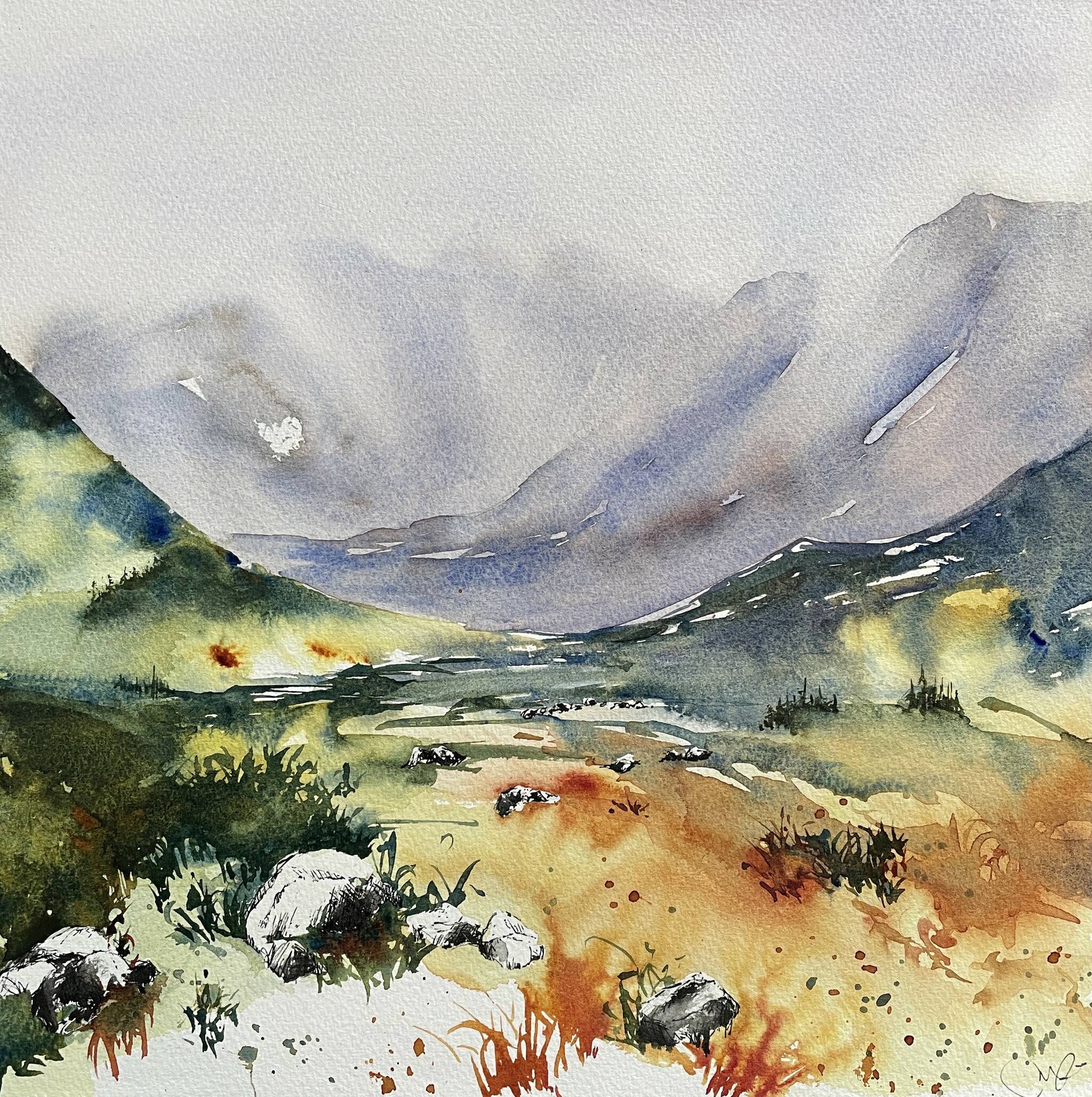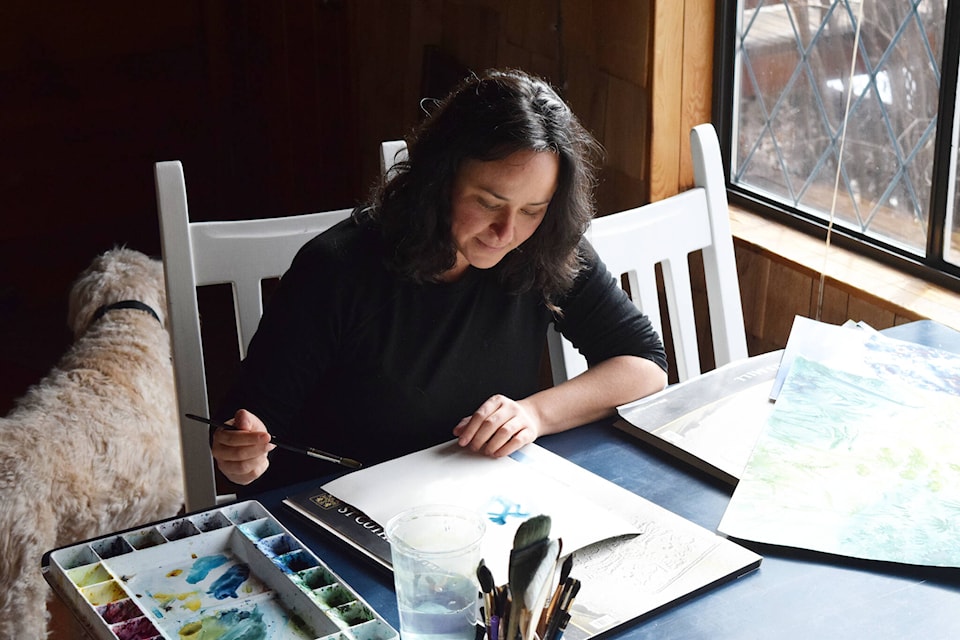Marie-Lou Lefrancois is reluctantly getting used to the limelight.
For the Smithers artist, what started out strictly as a hobby three years ago, has turned into a bit of side hustle as she launched her first solo show at the Smithers Art Gallery in the mini gallery last week.
Lefrancois said she was surprised when people showed interest in her watercolours. Then they started encouraging her to submit them to contests and she started to win prizes.
When someone encouraged her to submit a proposal for a show at the gallery, she thought, ‘sure, why not?’ But she never expected to get accepted.
“I’m always a bit stunned,” she said. “I’m very stunned about what’s happening at the gallery now. It’s a weird thing for me … there’s a lot of validation. And I’m not sure what to do with it.”
While she may not know what to do with it, she is grateful for how accepting and supportive the community has been.
“[It] is completely new to me, and I think it’s been incredible for us as a family and Nick (husband) playing in a band (Whiskey Rose) and Vivian (daughter) singing and just, you know, you’re able to do these things and people are so accepting and invite that.”
Lefrancois grew up in an artistic family. Her mother was an artist and her father worked in television. One of her sisters went on to be an accomplished painter and another is a teacher.
They lived in the cultural heart of Montreal, Que. In that environment, Lefrancois said, art was embedded in the life and culture all around her.
“There is a big snobbism about it, too, with art,” she said. “You know, is it not good enough? So, I never felt good enough, to be honest. And it was completely out-of-the-question for me to try to do anything.”
Nevertheless, she did pursue the arts in college, primarily photography, but hated it.
“You’re being judged all the time, you’re really exposing yourself all the time, like the way you take a picture, or the way you take your video,” she said. “There’s a huge judgmental aspect to it. At the end, they did some sort of weird exit interviews at that college when you’re done. And then they’re like, ‘so what do you want to do?’ And I said, I think I want to be a logger.”
She said when she decided she was going to go into forestry, it felt like a bit of a rebellion. It didn’t go over well.
It was also the impetus for her eventual relocation to the Bulkley Valley.
Like so many young Quebecers over the decades, Lefrancois’ first introduction to the Pacific province was tree planting.
“There’s definitely a bit of an exodus of Quebecers for jobs in B.C. because, you know, there’s also this B.C. aura about it,” she said, noting it was a great summer job for someone studying physical geography.
It was here, in the Northwest, the francophone Lefrancois met her now-husband Nick Thomas, a half-American anglophone.
“When Nick and I met we could barely understand each other,” she said. “The mispronounced words and misunderstandings are still something we laugh about,”
After their first summer together in the B.C. bush, she went back to Montreal and he returned to his business studies in Michigan. They carried on the relationship long-distance for a year until the next planting season and came back to the Northwest.
There were two key moments that cemented her eventual career path to her current gig as a stewardship policy forester with the provincial government.
The first was a day in Hazelton. While the planters were waiting to pick up their trees for the day, she asked to go into the forestry office there where she was enthralled by the maps and data and talking to the people who worked there.
The second was between planting season and the beginning of the new school year. Back in Michigan Nick had a side business doing commercial cleaning. One of his cleaning jobs was at a U.S. Forest Service building.
“So we went there to clean it, and I couldn’t clean it,” she explained. “I was just looking. Everybody had their maps. It was really cool, these maps, because you have these pictures of forests, like aerial pictures, and then they have little groupings of, you know, the timber profiles. and where you put the roads. And I was just, like, yeah, so I think that was one of the big triggers.”
After earning her bachelor’s degree in physical geography at the University of Montreal, Lefrancois went on to get a master’s in forest ecology through the Centre for Forest Research, a multi-university entity that pulls expertise from 11 Quebec universities and associated scientists from other universities and governmental institutions across Canada and beyond.
They moved to Smithers in 2007 where they have raised their family consisting of their two children, daughter Vivian Thomas (15) and son Eliot Thomas (12).
A few years back, Lefrancois decided she needed a hobby. Her first choice was horseback riding, but after trying to break the young horse she bought and having some close calls, she decided it was a bit too dangerous.
She had dabbled in painting using materials purchased for her kids who turned out “sadly” to be not very interested. Lefrancois wasn’t completely taken with it either until she took a holiday with her mother.
“She gave me a brush, it was a Russian squirrel brush,” Lefrancois explained. “It was just an incredible effect. When you start working with good material with watercolour, that’s what happened to me. I started painting with that quality and then it changed everything.”
From there, it was developing her technique by watching videos on YouTube.
“It was just something natural for me to just watch these videos, and people who are really good, and trying to absorb their techniques and do something that I want with that. And that learning for me was… a strong emotion.”
The pandemic also cemented her commitment to the art.
“It’s a pure escape,” she said. “You create this world of the colours your want, the light, the beauty you want. There’s a big thing for me with COVID and painting, because it just exploded for me. “
While Lefrancois is starting to enjoy some commercial success and plans to keep exhibiting looking forward to maybe even expanding beyond the valley, it is still fully a hobby for her.
“If people like my paintings, I think they should have them,” she said. “I don’t like to put like a big price tag on them. I don’t think they’re priced too low or too high.”
Lefrancois’s exhibition entitled “Loose Landscapes” is on now at the Smithers Art Gallery until April 2.
She said it felt great to be part of the return to normal exhibitions at the gallery with the first artist’s reception and full capacity event since the pandemic started.

